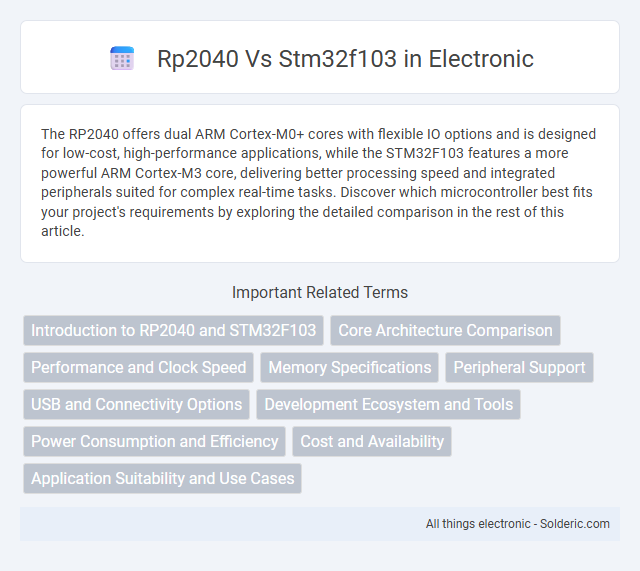The RP2040 offers dual ARM Cortex-M0+ cores with flexible IO options and is designed for low-cost, high-performance applications, while the STM32F103 features a more powerful ARM Cortex-M3 core, delivering better processing speed and integrated peripherals suited for complex real-time tasks. Discover which microcontroller best fits your project's requirements by exploring the detailed comparison in the rest of this article.
Comparison Table
| Feature | RP2040 (Raspberry Pi Pico) | STM32F103 |
|---|---|---|
| Core | Dual-core ARM Cortex-M0+ | Single-core ARM Cortex-M3 |
| Maximum Clock Speed | 133 MHz | 72 MHz |
| Flash Memory | External, up to 16 MB QSPI Flash | 64 to 128 KB Internal Flash |
| RAM | 264 KB SRAM | 20 KB SRAM |
| GPIO Pins | 30 multi-function GPIO | 37 GPIO pins |
| ADC Channels | 3x 12-bit ADC | 10x 12-bit ADC |
| Interfaces | 2x I2C, 2x SPI, 2x UART, USB 1.1 Device | 3x I2C, 2x SPI, 5x USART |
| Operating Voltage | 1.8 - 3.3V | 2.0 - 3.6V |
| Power Consumption | Low power with flexible sleep modes | Low power with multiple power modes |
| Development Ecosystem | C/C++, MicroPython SDK; strong Raspberry Pi community | C/C++ with STM32CubeMX & HAL libraries; extensive STM32 ecosystem |
Introduction to RP2040 and STM32F103
The RP2040 features a dual-core ARM Cortex-M0+ processor running up to 133 MHz, designed by Raspberry Pi for cost-effective and flexible embedded applications. The STM32F103 from STMicroelectronics houses a single-core ARM Cortex-M3 core clocked up to 72 MHz, offering rich peripheral options for industrial and consumer electronics. Your choice between these microcontrollers depends on processing power needs, peripheral availability, and ecosystem support.
Core Architecture Comparison
The RP2040 features a dual-core ARM Cortex-M0+ processor with a 133 MHz clock speed emphasizing low power consumption and efficient processing for embedded applications. In contrast, the STM32F103 is built around a single-core ARM Cortex-M3 core running up to 72 MHz, offering higher computational performance and advanced peripherals for real-time control. The Cortex-M3 core provides better interrupt handling and DSP instructions, while the Cortex-M0+ prioritizes minimal power usage and cost-effectiveness in microcontroller designs.
Performance and Clock Speed
The RP2040 features a dual-core ARM Cortex-M0+ processor running at up to 133 MHz, providing efficient multitasking for embedded applications. In contrast, the STM32F103 is powered by a single-core ARM Cortex-M3 CPU with clock speeds up to 72 MHz, offering robust performance for real-time operations. While the RP2040 excels in parallel processing and higher clock rates, the STM32F103 delivers strong deterministic performance suited for industrial control systems.
Memory Specifications
The RP2040 features 264KB of on-chip SRAM and supports external flash memory up to 16MB via a QSPI interface, offering flexible storage options for complex applications. In contrast, the STM32F103 provides up to 128KB of flash memory and 20KB of SRAM embedded on-chip, which limits its capacity for large data and code storage. Your choice depends on the memory requirements of your project, with the RP2040 excelling in applications demanding extensive RAM and external memory support.
Peripheral Support
The RP2040 microcontroller offers versatile peripheral support including dual ARM Cortex-M0+ cores, programmable I/O (PIO) blocks for custom protocols, USB 1.1 controller, and multiple SPI, I2C, and UART interfaces. The STM32F103 features an ARM Cortex-M3 core with extensive peripheral integration such as multiple timers, ADCs, USB full-speed device, CAN bus, and advanced communication interfaces like USART and SPI. While the RP2040 excels in flexible, programmable I/O with its PIO state machines, the STM32F103 provides a broader range of analog and communication peripherals suited for more complex embedded applications.
USB and Connectivity Options
The RP2040 features a USB 1.1 host/client controller that supports full-speed USB device mode, enabling easy connection to a wide range of peripherals and PCs. The STM32F103 offers USB 2.0 full-speed device functionality with better support for high-speed data transfer and enhanced device compatibility. Your project's connectivity needs will determine the choice, as RP2040 excels in simple USB device implementations while STM32F103 provides more advanced USB communication options.
Development Ecosystem and Tools
The RP2040 benefits from Raspberry Pi's extensive development ecosystem, featuring the versatile C/C++ SDK, MicroPython support, and the user-friendly Visual Studio Code integration, making rapid prototyping straightforward. STM32F103 offers a mature ecosystem with STM32CubeMX for peripheral configuration, STM32CubeIDE as an all-in-one development environment, and comprehensive middleware libraries, ideal for professional-grade embedded applications. Your choice depends on whether you prioritize community-driven tools and ease of use (RP2040) or robust industrial support and advanced configurability (STM32F103).
Power Consumption and Efficiency
The RP2040 microcontroller consumes approximately 30 mA at full operation, with power-saving modes reducing consumption to around 1.3 mA in dormant states. In comparison, the STM32F103 offers multiple low-power modes, achieving as low as 2 uA in standby mode, making it more efficient for ultra-low power applications. Efficiency depends on use case, with the STM32F103 excelling in low-power states while the RP2040 provides competitive performance in active power consumption.
Cost and Availability
The RP2040 microcontroller offers a very competitive cost advantage with unit prices often lower than those of the STM32F103, making it ideal for budget-sensitive projects. Availability of the RP2040 is generally strong due to Raspberry Pi's broad production capabilities and widespread adoption, though occasional supply chain disruptions may occur. In contrast, the STM32F103, produced by STMicroelectronics, benefits from a mature supply chain with extensive global distribution and a wide range of package options, often ensuring consistent availability for large-scale manufacturing.
Application Suitability and Use Cases
The RP2040 excels in hobbyist projects, educational tools, and lightweight embedded systems due to its dual-core ARM Cortex-M0+ and flexible GPIO options, making it ideal for rapid prototyping and custom peripherals. The STM32F103 offers greater processing power with its ARM Cortex-M3 core, extensive peripheral set, and real-time capabilities, making it suitable for industrial applications, motor control, and communication protocols. Your choice depends on whether you prioritize ease of use and low cost (RP2040) or robust performance and advanced peripheral support (STM32F103).
rp2040 vs stm32f103 Infographic

 solderic.com
solderic.com